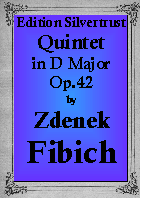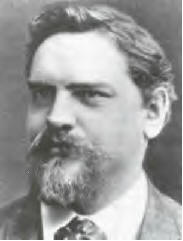Presents
Zdenek Fibich
|
Violin, Clarinet, Horn, Cello & Piano |
 |
 |
2 Violins, Viola, Cello & Piano |
Quintet in D Major, Op.42
For either Piano,Violin, Clarinet, Horn & Cello or Piano, 2 Violins, Viola and Cello
This is one of the most original sounding chamber music works because of the unusual tone color effects that Fibich creates. Clearly, in its original version for piano, winds and strings, the nature of the instruments, by themselves alone, creates the stunning and rich effects. However, the version for standard piano quintet benefited immeasurably because Fibich strove hard to maintain the wonderful tone color of the original.
Zdenek Fibich (1850-1950) is the third of the so-called Big Three of 19th century Czech composers, the other two being Smetana and Dvorak. That Fibich is not as well known as the other two is not because his music was in any way inferior, but simply because he lived during a time of extreme national consciousness and unlike Dvorak and Smetana, he did not choose only to write in a purely Czech idiom. Rather, his music, though exhibiting Slavic elements, is more typically Central European in sound. This reflects his background. One of his parents was Czech, the other an Austrian German. His education was at both Czech and German schools. He studied at the famous Leipzig Conservatory then spent a year in Paris. Hence Fibich, in contrast to either Dvorak or Smetana, was the product of two cultures, German and Czech. His instrumental works are generally in the vein of the German romantics such as Mendelssohn, Schumann and Wagner.
The Quintet dates from 1893. Because of the unusual combination of instruments Fibich selected for the original version, his publisher, knowing not many copies would be sold, asked for a version for standard piano quintet. This he produced and yet, such was Fibich's genius, that it in no way sounds like an arrangement and often even gives the feeling of being an altogether separate composition. The main theme to first movement, Allegro non tanto, is warm-hearted and presents a colorful reflection on the peacefulness of nature with a somewhat rustling quality in the background. There is a brief orchestral call to attention before the music seamlessly drifts away. The second movement, Largo, has for its main subject a melody which is serene and dignified but also capable of tremendous passion. A Schubertian Scherzo, with two trios comes next. Fibich gives the instruction "to be played with wild humor." The finale, Allegro con spirito, is bright, joyous and festive.
What a tremendous pity that a work so fine as this is virtually unknown. Long out of print, it is with pleasure that we reintroduce it. And we also offer three other fine works for this exact same combination for Violin, Clarinet, Horn, Cello and Piano: Quintet in c minor by Robert Kahn, Quintet in F Major by Waldemar von Baussnern and the Quintet in E flat by Thomas Dunhill both of which we heartily recommend as a fine companion work.
| (A) Violin, Clarinet, Horn, Cello & Piano | $39.95 |
|
| (B) Two Violins, Viola, Cello & Piano | $39.95 |
|
| (C) All Seven Parts | $47.95 |
|